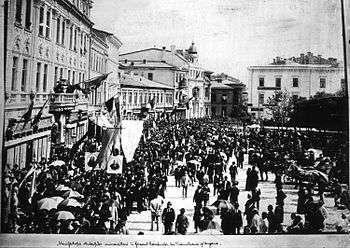Transylvanian Memorandum

up row, from left to right: Dionisie Roman, Patriciu Barbu, Dr. Daniil Popovici-Barcianu, Gherasim Domide, Dr. Teodor Mihali, Dr. Aurel Suciu, Mihaiu Veliciu, Rubin Patiția
down row, from left to right: Nicolae Cristea, Iuliu Coroianu, Gheorghe Pop de Băsești, Dr. Ioan Rațiu, Dr. Vasile Lucaciu, Dimitrie Comșa, Septimiu Albini


The Transylvanian Memorandum was a petition sent in 1892 by the leaders of the Romanians of Transylvania to the Austro-Hungarian Emperor-King Franz Joseph, asking for equal ethnic rights with the Hungarians, and demanding an end to persecutions and Magyarization attempts.
Status
After the Ausgleich of 1867, although Romanians formed the majority of Transylvania's population, they had not been awarded legal status as a nation.
The Memorandum itself was written by the leaders of the Romanian National Party of Transylvania and Banat (PNR) - among others, Ioan Rațiu, Gheorghe Pop de Băsești, Eugen Brote, Aurel Popovici, and Vasile Lucaciu. It asked for political rights to be awarded to Romanians, as well as initiating a debate on the Kingdom of Hungary's policies of intolerance towards Romanians.
Consequences
Franz Josef, without reading it, forwarded the memorandum to Budapest parliament, which, also without reading it, sent it back to the head of delegation. After printing and spreading the document the authors were charged with incitement committed through the press and most of them sentenced to prison ranging from two months to five years. Although in 1895 they were freed by royal amnesty, the outcome contributed to a decrease in loyalism to the Crown, with many leaders of the PNR turning towards the goal of union of Transylvania with Romania.
However, activism for union per se was largely held off until after World War I and the Treaty of Trianon, with Romania itself oscillating between alliances with the Central Powers and the Entente, and with the parallel offer made by Archduke Franz Ferdinand of Austria (the heir apparent) to negotiate for a compromise (see United States of Greater Austria).
See also
External links
| Wikimedia Commons has media related to Transylvanian Memorandum. |